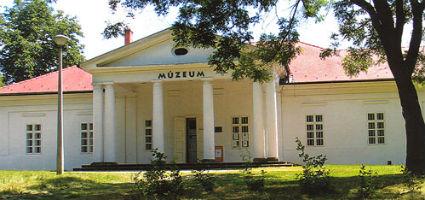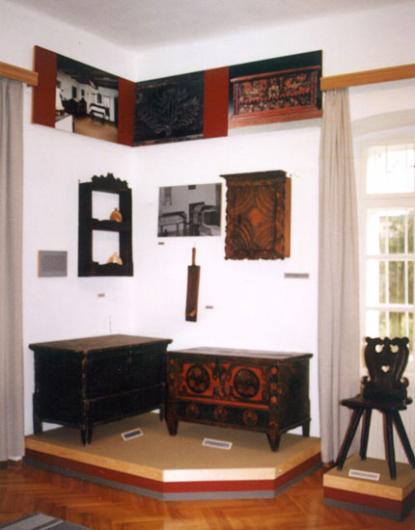2024. December 22. Sunday
Pál Kiss Museum - Tiszafüred
 |
Address: 5350, Tiszafüred Tariczky sétány 6.
Phone number: (59) 352-106
E-mail: kisspalmuz@gmail.com
Opening hours: Tue-Sat 9-12, 13-17
|
Museum tickets, service costs:
|
Ticket for adults
|
500 HUF
|
/ capita
|
|
Group ticket for adults
(min. 10 people)
|
150 HUF
|
/ capita
|
|
Ticket for students
|
250 HUF
|
/ capita
|
|
Ticket for pensioners
|
250 HUF
|
/ capita
|
|
Ticket for families
(2 adults + max. 3 children)
|
750 HUF
|
/ family
|
|
Program ticket
|
300 HUF
|
/ capita
|
|
Season ticket
|
1000 HUF
|
|
|
Group guide
(max. 40 people)
|
2000 HUF
|
/ group
|
|
Photography
|
1000 HUF
|
|
|
Video
|
1000 HUF
|
The artisans founded guilds at the beginning of the 19th century. The reason of the development of Tiszafüred into a center of commerce was the strengthening of trade from the middle of the 18th century.

Panels were made in many places of Hungary but among them, those made in Tiszafüred were the most famous. Some of them were even taken to Prussia. Under the time of the War of Independence, the panel makers still worked. Their work was necessary until 1868 when the hussar saddles appeared.
The saddle of Füred was made of two kinds of tree. The one on the back of the horse was made of soft wood. On those, two pommels was placed made of hard wood. The pommel was tied with leather, which was covered with either leather of sheep or stuffed leather. Some of the saddles were ornamented.
The other important trade was pottery. The glazed ceramics were extremely sought for. They were burned twice: for the first time they received the base color, the second time glaze was put on them and they were burned again which made them so shiny
In the last third of the 19th century, Tiszafüred became the second largest center for bowls. The ornamentation that had been used before changed: the new patterns were geometric.
By the first part of the 20th century, the pottery was not so sought for. The potters had to find another trade to work in. The pottery trade seized to exist completely after WWI.
The red furniture can be traced to the Reformation Age. At the beginning the painting of furnitures was dark, a harmonic bunch of flower was surrounded by a circle. The furniture were painted with red, yellow, blue, white, and sometimes with green.
At the beginning of the 19th century, the ornaments were painted on a new base. The ribs of trees were highlighted.
Instead of the circles, dense flowers were preferred from the last fourth of the 19th century. This kind of painted furniture was succeeded by the simple brown painted ones from the 20th century.
Beside the products of the trade, the visitors may see products of vernacular art at our exhibition as well. Textiles, embroidery, leather works, and carvings are also displayed.

Panels were made in many places of Hungary but among them, those made in Tiszafüred were the most famous. Some of them were even taken to Prussia. Under the time of the War of Independence, the panel makers still worked. Their work was necessary until 1868 when the hussar saddles appeared.
The saddle of Füred was made of two kinds of tree. The one on the back of the horse was made of soft wood. On those, two pommels was placed made of hard wood. The pommel was tied with leather, which was covered with either leather of sheep or stuffed leather. Some of the saddles were ornamented.
The other important trade was pottery. The glazed ceramics were extremely sought for. They were burned twice: for the first time they received the base color, the second time glaze was put on them and they were burned again which made them so shiny
In the last third of the 19th century, Tiszafüred became the second largest center for bowls. The ornamentation that had been used before changed: the new patterns were geometric.
By the first part of the 20th century, the pottery was not so sought for. The potters had to find another trade to work in. The pottery trade seized to exist completely after WWI.
The red furniture can be traced to the Reformation Age. At the beginning the painting of furnitures was dark, a harmonic bunch of flower was surrounded by a circle. The furniture were painted with red, yellow, blue, white, and sometimes with green.
At the beginning of the 19th century, the ornaments were painted on a new base. The ribs of trees were highlighted.
Instead of the circles, dense flowers were preferred from the last fourth of the 19th century. This kind of painted furniture was succeeded by the simple brown painted ones from the 20th century.
Beside the products of the trade, the visitors may see products of vernacular art at our exhibition as well. Textiles, embroidery, leather works, and carvings are also displayed.
